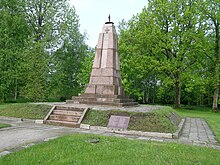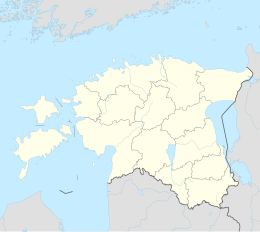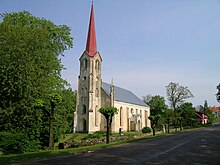Lihula
| Lihula | |||
|
|||
| State : |
|
||
| Circle : |
|
||
| Founded : | 1993 (city rights) | ||
| Coordinates : | 58 ° 41 ′ N , 23 ° 50 ′ E | ||
| Area : | 3.84 km² | ||
| Residents : | 1,338 (December 31, 2011) | ||
| Population density : | 348 inhabitants per km² | ||
| Time zone : | EET (UTC + 2) | ||
| Telephone code : | (+372) 477 | ||
| Postal code : | 90302 | ||
| Community type: | city | ||
| Mayor : | Varje Ojala-Toos
(Lihula Konservatiivne Vaba Kodanik) |
||
| Postal address : | Jaama 1 90302 Lihula |
||
| Website : | |||
|
|
|||
Lihula ( Lihula linn ; Eng. Leal ) is a city in the west of the Republic of Estonia . During the Middle Ages, the Lihula Castle and Nunnery were the powerhouses of the region.
Population and location
Lihula is located in the northwest of Pärnu County. The city has 1338 inhabitants (as of December 31, 2011). Since 1999 it belonged administratively to the rural community Lihula ( Lihula vald ) in the district of Lääne , when the district and city administration were merged; Lihula has been the administrative seat of the rural community of Lääneranna in Pärnu County since 2017 .
history
Ordensburg Leal
The settlement history of the place goes back to the middle of the first millennium after Christ at the latest. A fortress-like structure of the pagan Estonians has probably been in Lihula since the Iron Age . The first documentary mention dates from 1211.
At the beginning of the 13th century, the first Christian Crusader castle was built on the site. It was located in a place protected by moors on the strategically important connection from the Estonian mainland to the island of Saaremaa ( Ösel ).
Lihula was designated in 1211 by the Riga Archbishop Albert von Buxthoeven as the residence of the Bishop of Estonia, Theodoric . However, he was never able to move into the planned residence. The Order of the Brothers of the Sword probably only subjugated the area in 1218. Two years later, Lihula fell into the hands of Swedish troops under King John I without a fight , but was then destroyed by local residents in the Battle of Lihula on August 8, 1220. Among the dead were the Swedish folk kings Jarl Karl der Taube and Bishop Karl Magnusson von Linköping .
After the Ösel-Wiek diocese was founded in 1228, the bishop and the Livonian Order built a joint castle in Lihula between 1238 and 1242. Today's settlement was built around them. In 1251 the bishop moved his residence to Vana-Pärnu (and in 1265 to Haapsalu ), which diminished the importance of Lihula.
In 1298 the settlement was badly damaged during armed conflict, but was later rebuilt. It was not until the Livonian War in the middle of the 16th century that the castle was destroyed, apart from a few buildings. From then on, the ruins served as a quarry. Today some remains, such as the foundation walls and cellars of the core castle and an archway of the outer castle are preserved.
monastery
Since the 13th century, Lihula was also the seat of a Cistercian nunnery . It was founded at the instigation of Bishop Hermann I von Buxthoeven mainly as a place for noble ladies of the province. The monastery owned numerous lands in the area.
The fort-like monastery complex near the castle was surrounded by a curtain wall. The buildings stretched relatively freely around an inner courtyard. The monastery church was in the south wing of the main house. There was no actual cloister .
The monastery complex was probably destroyed in 1570. The ruins were almost completely demolished during the 17th and 18th centuries.
16th Century
The history of Lihula in the 16th century was marked by heavy armed conflicts and numerous changing rulers. The Livonian War left deep marks. The Swedes conquered the settlement in 1563 and 1570, between 1563 and the mid-1570s it belonged alternately to local magnates and Danish troops, it was Danish again in 1575/76, and then Russian from 1576 to 1581.
It was not until 1581 that Swedish rule over the region - until the Russian conquest of Estonia in the Northern War (1700–1721) - brought a long period of peace.
Good from Lihula
From 1631 to the end of the 17th century, the Swedish crown gave Lihula as a fief to the family of the Swedish military Åke Tott (1598–1640). At Tott's instigation, the founding of the local estate declined in the early 1630s.
In 1726 the estate fell to the noble Baltic German family Hahn , and in 1795 to Karl Friedrich von Stackelberg. From 1812 Lihula belonged to the von Wistinghausen family . From 1874 until it was expropriated as part of the Estonian land reform in 1919 , the estate was owned by the noble Buxhoeveden family .
Today's mansion was built on a hill in the 1820s. The two-storey stone building was built in the classicism style. The facade of the representative building is adorned by a portico with four columns.
After the Soviet occupation of Estonia, the manor house housed the administration of a sovkhoz . Since 1994, the Lihula City Museum has been located in the renovated building.
Modern times
It was not until the second half of the 19th century that the Lihula settlement rose again to become an important center of western Estonia. The economy and trade gained momentum and the population grew.
After Estonian independence was proclaimed, the railway line between the Virtsu ferry port and the city of Rapla was built in 1931 . The station dynamized Lihula's economic development. The water tower, built in 1930/31, is the city's landmark today. In 1968 the narrow-gauge line was closed.
1945 Lihula was given the rank of large village ( alevik ). From 1951 to 1961 Lihula was the capital of the raion of the same name .
In 1993, after Estonian independence was regained, Lihula received city rights. In 1999 the city ( Lihula linn ) and the rural community of Lihula ( Lihula vald ) were combined into one administrative unit. Since 2017, the city has been part of the once again merged rural community Lääneranna ( Lääneranna vald ).
Education, culture, economy
Today the city of Lihula with its grammar school, music and art school and the culture house built in 1991 is again the center of the region. Companies for food processing (baked goods), textile production (sports and swimwear as well as carpets) and the building materials trade have settled in the place.
The most important cultural festival in Lihula's calendar are the Music Days ( Lihula Muusikapäevad ), which have been taking place every summer since 2009. The international "Matsalu Nature Film Festival" takes place every autumn.
Monuments

The Volkspark houses the monument to those who fell in the Estonian War of Independence against Soviet Russia (1918–1920) and a memorial stone for the Estonian writer Jakob Pärn (1843–1916). Pärn, one of the most prominent representatives of the awakening Estonian national consciousness in the second half of the 19th century, worked as a teacher in Lihula for more than ten years from 1871.
Lihula briefly attracted international attention in 2004 when the city council erected a memorial to Estonian soldiers who fought on the German side against the Soviet Union during World War II . The monument was removed a short time later by order of the Estonian Minister of the Interior, Margus Leivo . In September 2004 riots broke out between townspeople and the Estonian police.
Elisabeth Church
The first church in Lihula was probably built as early as the 13th century. From 1241 the existence of a local priest is documented.
Today the landmark of the place is the Evangelical Lutheran Elisabeth Church. The single-nave church in neo -Gothic style was built from 1876 to 1878 on the same site as the previous church. The architect of the building with its slim, high tower was Johann Gottfried Mühlenhausen , who had built numerous church buildings in Estonia.
The altar cabinet and the pulpit are the work of the local master carpenter Friedrich Laurberg. The organ was made by the Estonian organ builder Carl August Tanton in 1845/46.
sons and daughters of the town
From 1783 to 1796 Joachim Gottlieb Schwabe (1754–1800) was pastor in Lihula. The versatile calendar writer worked to raise the level of education of the rural Estonian population.
The lepidopterologist (butterfly scientist ) Wilhelm Konstantin Fromhold Petersen (1854–1933) and the lawyer and Soviet People's Commissar Paul Vihalem (1910–1985) were born in Lihula .
Web links
- Description (Estonian)
- Entry in Eesti Entsüklopeedia (online version)
- Lihula Castle and Manor (Estonian)
- Tourism in and around Lihula (German)
- Festival "Lihula Music Days" (Estonian)
Individual evidence
- ↑ corresponds to a free group of voters
- ↑ http://pub.stat.ee/
- ↑ http://register.muinas.ee/?menuID=monument&action=view&id=15473
- ↑ http://www.baltictimes.com/news/articles/10835/
- ↑ http://www.eestigiid.ee/?SCat=10&CatID=0&ItemID=49






